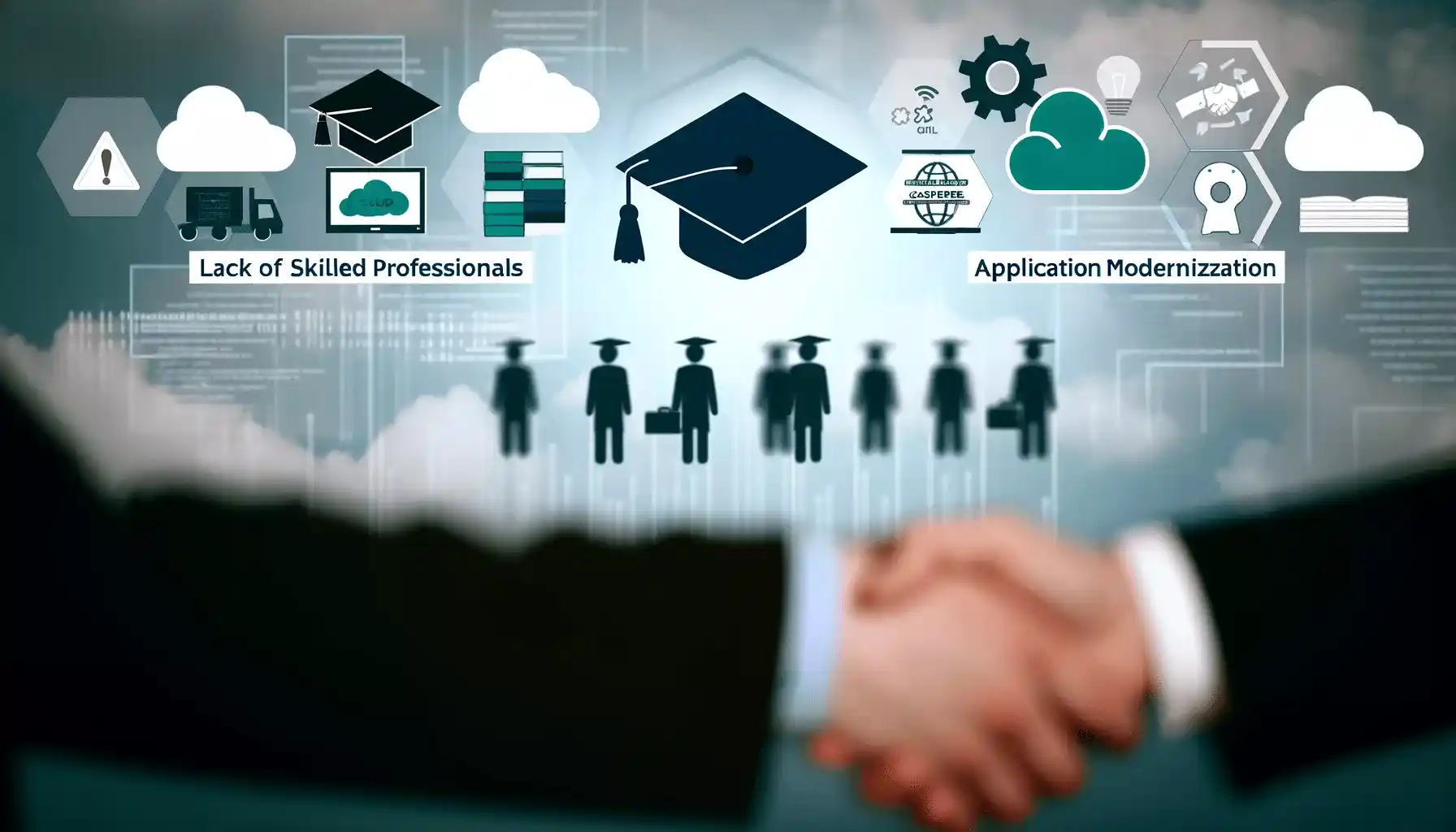Table of Contents
Legacy applications are the backbone of many organizations, but as technology evolves, they can become a hindrance to innovation and growth. Modernizing these applications is essential for staying competitive in today’s fast-paced digital landscape. Organizations heavily invest in custom applications crucial for business operations.
However, as time progresses, these applications become outdated, making replacement impractical due to established dependencies. Yet, legacy applications can undergo updates and reconfiguration to integrate seamlessly with modern, efficient platforms, moving away from legacy monolithic frameworks.
Transitioning legacy applications to the cloud provides extensive advantages, including platform flexibility, enhanced scalability, robust security, and cross-platform compatibility. This article explores the benefits of Legacy App Modernization challenges and typical strategies for migrating a legacy desktop application to cloud-based environments.
Introduction to Legacy Application Modernization

Legacy applications represent a significant investment for organizations, but they often pose challenges in terms of maintaining competitiveness in today’s rapidly evolving digital landscape. These applications are typically built on tightly coupled, monolithic architectures, making them vulnerable to emerging security threats, resistant to change, and limited in scalability.
As businesses face shifting market dynamics and evolving consumer behaviors, there’s a growing need for organizations to modernize their legacy applications to remain agile and responsive to change.
Legacy App Modernization challenges offer a strategic approach to transforming existing software to align with modern technologies and platforms. This involves various methods, including rewriting the source code, enhancing existing functionalities, or integrating legacy systems with modern applications and platforms.
By modernizing legacy applications, organizations can unlock new opportunities for innovation, improve scalability, and enhance overall competitiveness in the digital age.
Key Reasons to Modernize Legacy Applications
Legacy application modernization offers organizations numerous benefits, enabling them to stay competitive, adapt to evolving consumer needs, and leverage advanced technology for enhanced efficiency. Some of the key reasons organizations choose to embrace app modernization include:
Business Factors:
- Cost Reduction: Aging applications often incur higher maintenance costs, making modernization a cost-effective solution in the long run.
- Competitive Advantage: Modernized systems provide organizations with a competitive edge through improved performance and agility.
- Efficiency and Innovation: Modernized legacy app challenges offer enhanced scalability, enabling flexible deployment and automation, thus fostering innovation and efficiency.
- Improved Customer Satisfaction: Modernized applications meet modern performance and user experience standards, leading to higher customer satisfaction.

Technical Factors:
- API Integration: Modernized applications facilitate seamless integration with other software and third-party tools through standardized APIs.
- Security Enhancement: Modernization ensures applications are protected against evolving security threats, enhancing overall data security.
- Enhanced Performance: Modernized applications exhibit improved performance, reduced security risks, and reliable processes.
- Adoption of Efficient Operating Models: Modernization enables organizations to adopt efficient frameworks like DevOps, streamlining development and deployment processes.
Legacy App Modernization Challenges
Legacy app modernization challenges, including high cloud migration costs, a shortage of skilled professionals, risks and conflicts, a cost-intensive approach, and the potential for vendor lock-in.
Overcoming these hurdles requires strategic planning, collaboration, and the adoption of modern technologies. Organizations can mitigate high costs by implementing phased migration approaches and leveraging cost optimization tools. Addressing skill shortages involves investing in training programs and partnering with external experts.
Effective communication and risk management strategies are essential to navigate conflicts and mitigate risks. Adopting modernization strategies focused on business value and avoiding vendor lock-in through multi-cloud or hybrid-cloud approaches ensure long-term success.
1. High Cloud Migration Costs
- Challenge: Transitioning legacy App Modernization Challenges to the cloud can incur significant upfront costs, including infrastructure setup, data migration, and licensing fees.
- Solution: Implement a phased migration approach to spread costs over time. Start with non-critical applications or components and gradually move towards more mission-critical systems. Utilize cost optimization tools provided by cloud service providers to manage expenses efficiently. For example, Netflix successfully migrated its legacy monolithic architecture to the cloud by prioritizing critical components and leveraging cloud-native services like AWS Lambda and Amazon DynamoDB.
2. Lack of Skilled Professionals
- Challenge: App modernization challenges include finding skilled professionals proficient in both legacy systems and modern technologies like cloud computing, microservices, and DevOps, which can be challenging.
- Solution: Invest in training and upskilling programs for existing IT staff to bridge the skill gap. Additionally, collaborate with external consultants or specialized firms with expertise in legacy app modernization Challenges. For instance, General Electric partnered with external vendors to train its workforce and successfully modernize its legacy applications, leading to improved operational efficiency and reduced costs.

3. Risk and Conflict
- Challenge: Legacy app modernization challenges projects often face resistance from stakeholders due to concerns about data security, system reliability, and business continuity.
- Solution: Foster a culture of collaboration and communication among all stakeholders to address concerns and mitigate risks effectively. Conduct thorough risk assessments and develop contingency plans to handle potential disruptions during the modernization process. Moreover, demonstrates the benefits of modernization through pilot projects or proof-of-concept initiatives. For example, IBM overcame resistance by engaging stakeholders early in the process, aligning modernization goals with business objectives, and showcasing successful case studies to build confidence and trust.
4. Cost-Intensive Approach
- Challenge: Traditional approaches to legacy app modernization, such as lift-and-shift or re-platforming, can be cost-intensive and may not deliver the desired outcomes.
- Solution: Adopt modernization strategies that prioritize business value and incremental improvements, such as refactoring legacy code, containerization, or adopting serverless architectures. Focus on optimizing costs by leveraging cloud-native services and automation tools. For instance, Capital One reduced costs and improved scalability by modernizing its legacy banking systems using a microservices architecture and cloud-native technologies, enabling faster feature delivery and better customer experiences.
5. Vendor Lock-in Situation
- Challenge: Depending heavily on a single cloud service provider for legacy app modernization challenges can lead to vendor lock-in, limiting flexibility, and increasing dependency.
- Solution: Embrace a multi-cloud or hybrid cloud strategy to avoid vendor lock-in and leverage the best features of different cloud platforms. Implement containerization and container orchestration tools like Kubernetes to achieve portability across cloud environments. For example, Spotify adopted a multi-cloud strategy to avoid vendor lock-in and ensure resilience, allowing them to seamlessly switch between cloud providers based on cost and performance considerations.

Conclusion
In conclusion, navigating legacy app modernization challenges requires a holistic approach that addresses technical, financial, and organizational factors. Despite the obstacles, organizations can overcome these challenges by embracing strategic planning, collaboration, and the adoption of modern technologies.
By prioritizing business value, optimizing costs, and fostering a culture of innovation and continuous improvement, organizations can successfully modernize their legacy applications.
Additionally, leveraging multi-cloud or hybrid cloud strategies can mitigate the risk of vendor lock-in and provide flexibility and scalability. With careful planning and execution, organizations can unlock the full potential of their legacy applications, driving innovation, efficiency, and competitiveness in today’s digital landscape.
Embracing app modernization challenges as opportunities for growth and transformation is key to staying ahead in the rapidly evolving technology landscape.





